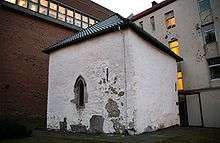Nonneseter Abbey, Bergen

Nonneseter Abbey (Nonneseter kloster) was a nunnery in Bergen, Norway. A small part of the former abbey church remains in use as a chapel, the Nonneseter kapell ("Nonneseter Chapel").
History
Nonneseter Abbey is first recorded by name in 1262, was but certainly founded many years earlier, possibly in about 1150.[1] It was dedicated to the Virgin Mary. The nuns apparently belonged to the Cistercian Order, although this is not confirmed until as late as 1494.
It seems probable that a hospital run by the nuns, documented in 1411, was the forerunner of the later St. George's (Sankt Jørgens) lepers' hospital.
In 1507 the nuns were ejected for immoral and unseemly behaviour and the buildings were transferred to the Hospital Brothers of St. Anthony. The nunnery was secularised in 1528, and the premises were converted into a private fortified residence, under the name of Lungegården, by the new proprietor, Vincens Lunge.
Site and buildings
The abbey was located on a promontory on the north bank of the Lillestrømmen, a stream which once connected two bodies of water, Store Lungegårdsvannet and Lille Lungegårdsvannet, approximately in the area of the present Kaigaten.
The surviving buildings were mostly destroyed by a fire in 1891, and of the monastic buildings there remains nothing to be seen. Of the abbey church there survived the base of the west tower, and the Nonneseter Chapel, originally the south chapel off the choir, which were acquired in 1891 after the fire by the Society for the Preservation of Ancient Norwegian Monuments.
The single storey remaining of the west tower, the Tårnfoten ("tower foot"), is near the present Bergen public library, and measures 8.6 metres square. It was originally clad with dressed stone. In the west wall is a portal with a round arch, and in the east wall another, which would have connected to the body of the church.
It is now used as a memorial chapel to the fallen of World War II.
The Romanesque tower foot is more old-fashioned in style than the body of the main church apparently was, indicating the possibility that it could have belonged to an older structure predating the arrival of the Cistercians with their characteristic building style.
The church lay to the east of the tower. The original building was quite small, but seems to have been extended eastwards in the later 13th century with a new choir and choir chapels; it had a single aisle. The graveyard was to the north of the church, and the monastic buildings to the south, but there are too few remains of them to establish the exact layout.
The site was archaeologically excavated in 1872 and again in 1892.
Nonneseter Chapel
The Nonneseter Chapel (Nonneseter kapell) at Kaigaten 3 is believed to have been one of the choir chapels. It measures about 8 metres by 7 metres, and contains a vaulted ceiling and Gothic arched windows. It dates from around 1250, which seems to be when the church was extended. Between 1951 and 1989 it was used as a church for deaf people. It is now used for various purposes, including as a concert hall.
Notes
- ↑ Its foundation may have been connected with that of Lyse Abbey, Os, in 1146 by Sigurd, Bishop of Bergen
Sources
- Norske kloster i middelalderen: Nonneseter kloster, Bergen (Norwegian)
- Histos.no: Nonneseter kloster (Norwegian)
- Kunsthistorie: Images
References
- Bendixen, B. E., 1893: Nonneseter klosterruiner in Kunst og haandverk fra Norges Fortid. Bergen: Foreningen til norske fortidsmindesmærkers bevaring
- Lidén, H.-E., and Magerøy, E. M., 1980: Norges kirker. Bergen, pp. 161–170. Bergen.
Coordinates: 60°23′23.93″N 5°19′57.13″E / 60.3899806°N 5.3325361°E